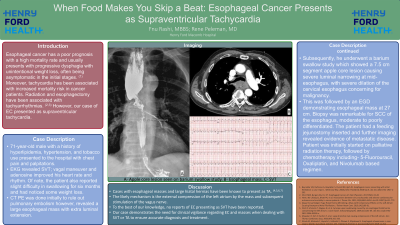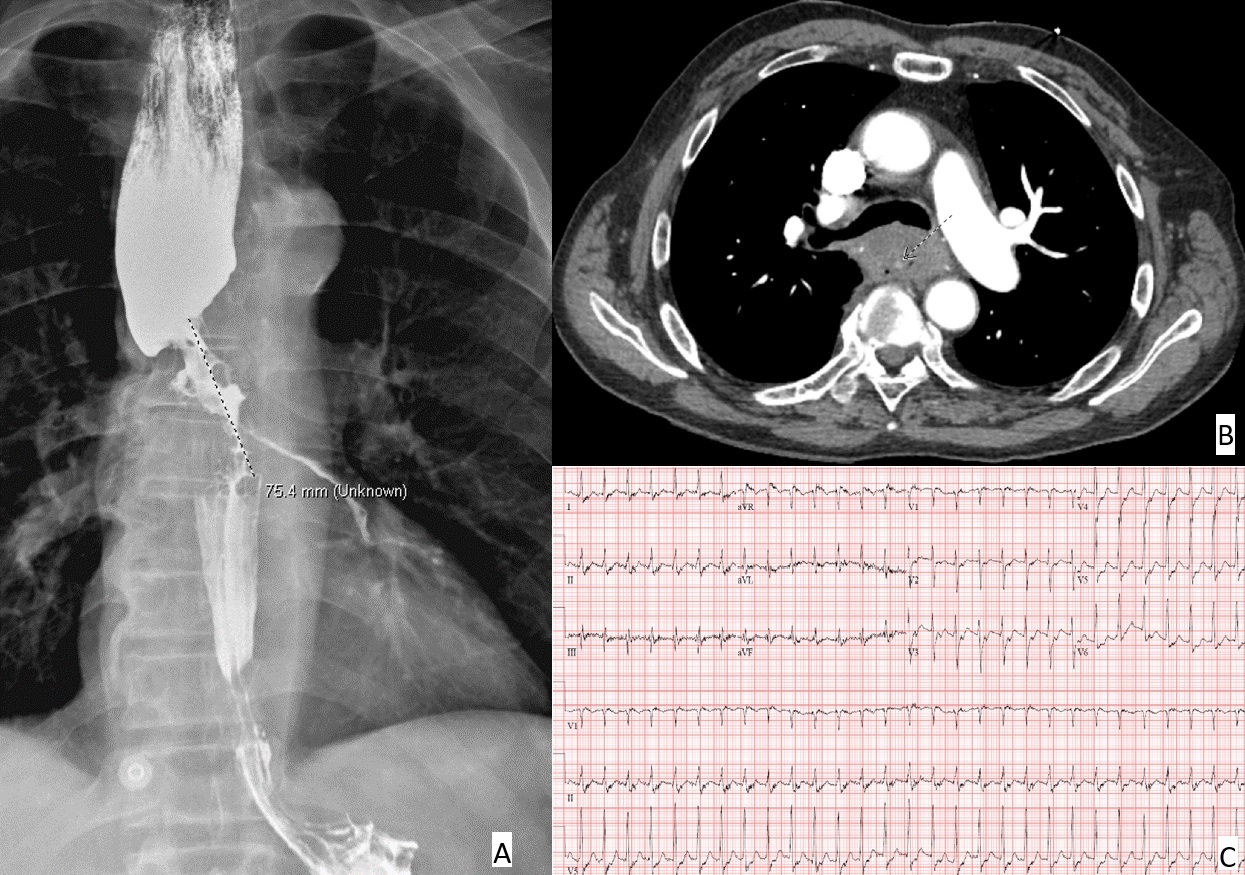Monday Poster Session
Category: Esophagus
P2318 - When Food Makes You Skip a Beat: Esophageal Cancer Presents as Supraventricular Tachycardia
Monday, October 28, 2024
10:30 AM - 4:00 PM ET
Location: Exhibit Hall E

Has Audio

Fnu Rashi, MBBS
Henry Ford Macomb Hospital
Clinton Township, MI
Presenting Author(s)
Fnu Rashi, MBBS, Rene Peleman, MD
Henry Ford Macomb Hospital, Clinton Township, MI
Introduction: Esophageal cancer (EC) has a poor prognosis with a high mortality rate and usually presents with progressive dysphagia with unintentional weight loss, often being asymptomatic in the initial stages. (1) Moreover, tachycardia has been associated with increased mortality risk in cancer patients. Radiation and esophagectomy have been associated with tachyarrhythmias (TA). (2,3) However, our case of EC presented as supraventricular tachycardia (SVT).
Case Description/Methods: 71-year-old male with a history of hyperlipidemia, hypertension, and tobacco use presented to the hospital with chest pain and palpitations. Initial electrocardiogram revealed SVT; vagal maneuver and adenosine improved his heart rate and rhythm. Of note, the patient also reported slight difficulty in swallowing for six months and had noticed some weight loss. Computed tomography pulmonary angiography was done initially to rule out pulmonary embolism however, revealed a large esophageal mass with extraluminal extension. Subsequently, he underwent a barium swallow study which showed a 7.5 cm segment apple core lesion causing severe luminal narrowing at mid-esophagus, with severe dilation of the cervical esophagus concerning for malignancy. This was followed by an esophagogastroduodenoscopy (EGD) demonstrating esophageal mass at 27 cm with a small amount of oozing blood. Biopsy was remarkable for squamous cell carcinoma of the esophagus, moderate to poorly differentiated. The patient had a feeding jejunostomy inserted and further imaging revealed evidence of metastatic disease to the skull and distal right femur. Patient was initially started on palliative radiation therapy, followed by chemotherapy including- 5-Fluorouracil, Oxaliplatin, and Nivolumab based regimen, and has received six cycles so far.
Discussion: Cases with esophageal masses and large hiatal hernias have been known to present as TA. (4,5,6,7) The likely mechanism is the external compression of the left atrium by the mass and subsequent stimulation of the vagus nerve. To the best of our knowledge, no reports of EC presenting as SVT have been reported. Our case demonstrates the need for clinical vigilance regarding EC and masses when dealing with SVT or TA to ensure accurate diagnosis and treatment.

Disclosures:
Fnu Rashi, MBBS, Rene Peleman, MD. P2318 - When Food Makes You Skip a Beat: Esophageal Cancer Presents as Supraventricular Tachycardia, ACG 2024 Annual Scientific Meeting Abstracts. Philadelphia, PA: American College of Gastroenterology.
Henry Ford Macomb Hospital, Clinton Township, MI
Introduction: Esophageal cancer (EC) has a poor prognosis with a high mortality rate and usually presents with progressive dysphagia with unintentional weight loss, often being asymptomatic in the initial stages. (1) Moreover, tachycardia has been associated with increased mortality risk in cancer patients. Radiation and esophagectomy have been associated with tachyarrhythmias (TA). (2,3) However, our case of EC presented as supraventricular tachycardia (SVT).
Case Description/Methods: 71-year-old male with a history of hyperlipidemia, hypertension, and tobacco use presented to the hospital with chest pain and palpitations. Initial electrocardiogram revealed SVT; vagal maneuver and adenosine improved his heart rate and rhythm. Of note, the patient also reported slight difficulty in swallowing for six months and had noticed some weight loss. Computed tomography pulmonary angiography was done initially to rule out pulmonary embolism however, revealed a large esophageal mass with extraluminal extension. Subsequently, he underwent a barium swallow study which showed a 7.5 cm segment apple core lesion causing severe luminal narrowing at mid-esophagus, with severe dilation of the cervical esophagus concerning for malignancy. This was followed by an esophagogastroduodenoscopy (EGD) demonstrating esophageal mass at 27 cm with a small amount of oozing blood. Biopsy was remarkable for squamous cell carcinoma of the esophagus, moderate to poorly differentiated. The patient had a feeding jejunostomy inserted and further imaging revealed evidence of metastatic disease to the skull and distal right femur. Patient was initially started on palliative radiation therapy, followed by chemotherapy including- 5-Fluorouracil, Oxaliplatin, and Nivolumab based regimen, and has received six cycles so far.
Discussion: Cases with esophageal masses and large hiatal hernias have been known to present as TA. (4,5,6,7) The likely mechanism is the external compression of the left atrium by the mass and subsequent stimulation of the vagus nerve. To the best of our knowledge, no reports of EC presenting as SVT have been reported. Our case demonstrates the need for clinical vigilance regarding EC and masses when dealing with SVT or TA to ensure accurate diagnosis and treatment.

Figure: A- Apple core lesion seen on barium swallow study. B- Esophageal mass. C- SVT
Disclosures:
Fnu Rashi indicated no relevant financial relationships.
Rene Peleman indicated no relevant financial relationships.
Fnu Rashi, MBBS, Rene Peleman, MD. P2318 - When Food Makes You Skip a Beat: Esophageal Cancer Presents as Supraventricular Tachycardia, ACG 2024 Annual Scientific Meeting Abstracts. Philadelphia, PA: American College of Gastroenterology.
